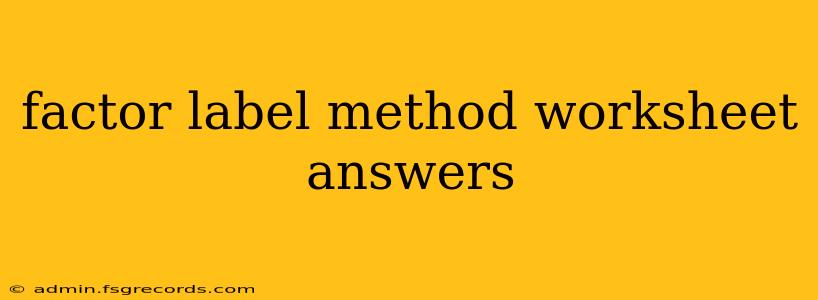Mastering the Factor-Label Method: A Comprehensive Guide with Worked Examples
The factor-label method, also known as dimensional analysis, is a powerful tool for solving chemistry problems and converting units. It's a systematic approach that ensures you're using the correct units and performing the necessary calculations accurately. This guide will walk you through the method, provide example problems with detailed solutions, and offer tips for mastering this essential skill.
What is the Factor-Label Method?
The factor-label method relies on the principle that multiplying a quantity by a fraction equal to one (1) does not change the quantity's value, only its units. We use conversion factors – fractions representing equivalent measurements – to cancel out unwanted units and arrive at the desired units.
Key Steps:
-
Identify the given quantity and desired units. Clearly state what you're starting with and what you want to end up with.
-
Find appropriate conversion factors. These are usually found in reference tables, textbooks, or online resources. Ensure the units are correctly arranged to cancel out unwanted units.
-
Set up the calculation. Arrange the given quantity and conversion factors in a chain, ensuring that unwanted units cancel out diagonally.
-
Perform the calculation. Multiply the numerators and divide by the denominators.
-
Check your answer. Does the answer have the correct units and make logical sense?
Example Problems with Solutions:
Problem 1: Converting Kilometers to Miles
Convert 15 kilometers (km) to miles (mi). Assume 1 mile = 1.609 kilometers.
Solution:
- Given: 15 km
- Desired: miles (mi)
- Conversion Factor: (1 mi / 1.609 km)
- Calculation: 15 km * (1 mi / 1.609 km) = 9.32 mi
Therefore, 15 kilometers is approximately equal to 9.32 miles. Note how the "km" units cancel out, leaving us with the desired "mi" units.
Problem 2: Converting Grams to Milligrams
Convert 250 grams (g) to milligrams (mg).
Solution:
- Given: 250 g
- Desired: mg
- Conversion Factor: (1000 mg / 1 g) (Since there are 1000 milligrams in 1 gram)
- Calculation: 250 g * (1000 mg / 1 g) = 250000 mg
Therefore, 250 grams is equal to 250,000 milligrams. Again, the grams cancel out, yielding the answer in milligrams.
Problem 3: More Complex Conversion
Convert 50 cubic centimeters (cm³) to liters (L), knowing that 1 mL = 1 cm³ and 1000 mL = 1 L.
Solution:
- Given: 50 cm³
- Desired: L
- Conversion Factors: (1 mL / 1 cm³), (1 L / 1000 mL)
- Calculation: 50 cm³ * (1 mL / 1 cm³) * (1 L / 1000 mL) = 0.05 L
Therefore, 50 cubic centimeters is equal to 0.05 liters. Observe how both cm³ and mL units cancel out.
Tips for Success:
- Write neatly: A clear and organized approach is crucial for avoiding errors.
- Always include units: This helps you track units and ensure they cancel correctly.
- Practice regularly: The more you practice, the more comfortable and proficient you will become.
- Check your work: Make sure your answer makes sense in the context of the problem.
By following these steps and practicing regularly, you can confidently master the factor-label method and solve a wide range of unit conversion problems. Remember, the key is to systematically use conversion factors to cancel units and reach your desired answer.

